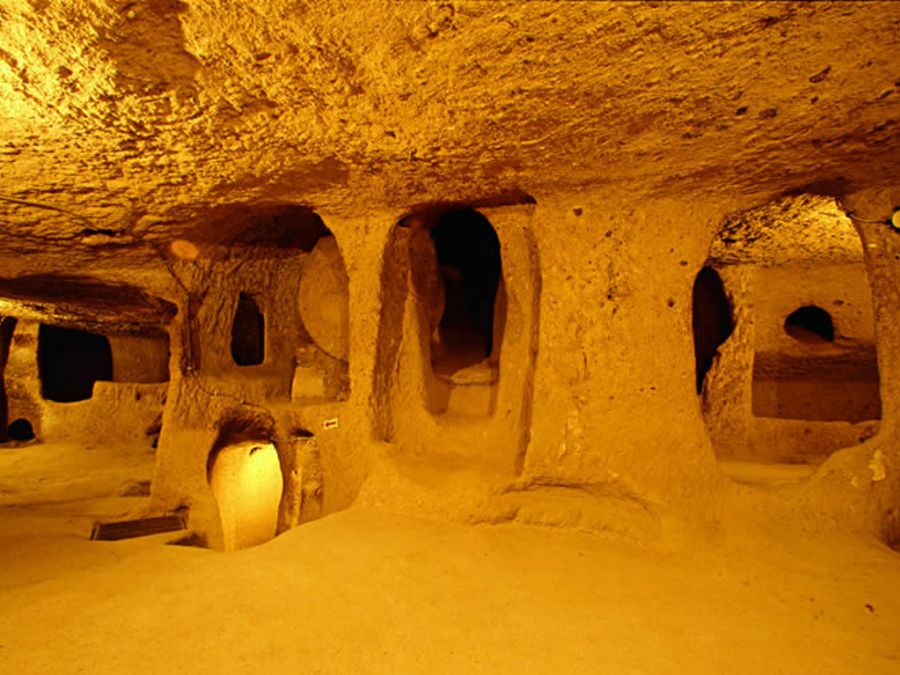Derinkuyu Underground City
Derinkuyu Underground City is the largest city in the underground city with more than 200 numbers in the Cappadocia region. Having a depth of 85 meters and spreading over a very wide area, Derinkuyu is a place to be protected in the unique geological formation of Cappadocia.
Derinkuyu, located 30 km from Nevşehir on the Nevşehir-Nigde motorway, has been cleaned eight times today. However, the gigantic city is thought to have gone down to 10 to 12 kata.
Derinkuyu Underground City consists of sections that will be housed in a large community and meet their needs. At the same time, unlike Kaymaklı Underground City, which is very similar to itself, there is also a missionary school, a place of confession, a christening pool and an interesting well.
Derinkuyu Underground City
Derinkuyu Underground City was discovered by chance in 1963 and opened in 1967. The city of Derinkuyu, formerly known as Melogobia, Malakopi, Melegobia or Melegobia, connected to Nevsehir, is the largest navigable underground city of Cappadocia. Derinkuyu’s drinking water needs to be removed from the wells at a depth of 60-70 meters, the town has taken the name Derinkuyu.
Derinkuyu dates back to the Assyrian colonies. It is known that the first Christians who escaped from the Roman Empire in the 2nd century AD and came to Cappadocia through Antakya and Kayseri settled here and protected the Roman soldiers from the attacks of the Arab raids first. There are sections in underground cities where entries can not be easily noticed and are protected by various pitfalls, where people may have to live without going out for a long time.
Covering a total area of ??four square kilometers with 2,500 square meters of covered area and unpaved areas, the depth of the cleaned eight floors is reduced to 50 meters. It is estimated that the depth of the Derinkuyu Underground City can be reached to 12 or 13 floors if it is completely cleaned and 85 meters deep. So, when you look at the wells that have no connection with the earth, it seems that this depth has dropped to 70-85 meters.
The underground cities formed by the carving, excavation and carvings of the easily formed tuff site of the Cappadocia region are entered through a narrow entrance, which is not obvious when viewed from the outside. The floors of the city are connected to each other by curved or stepped corridors. In Derinkuyu Underground City it is possible to see that the residential areas, defense, ventilation and production areas are inside. Some rooms are connected to each other by narrow tunnels that a person can pass through in the city where the storage rooms, ventilation chimneys, wine producers, churches, monasteries, water wells, toilets and meeting rooms are located.
At the entrance and exit of the tunnels there are large stone cylinders which are used to close the tunnels for safety reasons. These stone masses, which allow the doors to be closed behind the door when necessary, are called ‘Tigris’. These cylinders, which resemble a large stone wheel, prevent potential hazards by closing the doors.
Derinkuyu Underground City, with all the characteristics of the underground cities found in the Cappadocia region, has unique structural differences.
Derinkuyu has a missionary school on the second floor, as well as sections like stables, cellars, cafeterias, churches, shirahane which are the same as the others. The school’s tannery, which is torn in a large area, is covered with a cradle vault. The rooms on the left side of the hall are in the form of study rooms.
After the third and fourth floors of Derinkuyu Underground City, they are descending down the stairs. These churches, which are descended deeply in direct line, reach the cross-planned church. The ventilation pit at 55 meters deep, which is connected to the earth, is also used as a water well. From these wells extending to the bottom floors, every floor of the city can not benefit. On the other hand, the mouth of some wells was made unconnected with the earth to prevent poisoning at the time of invasion.
MORE













